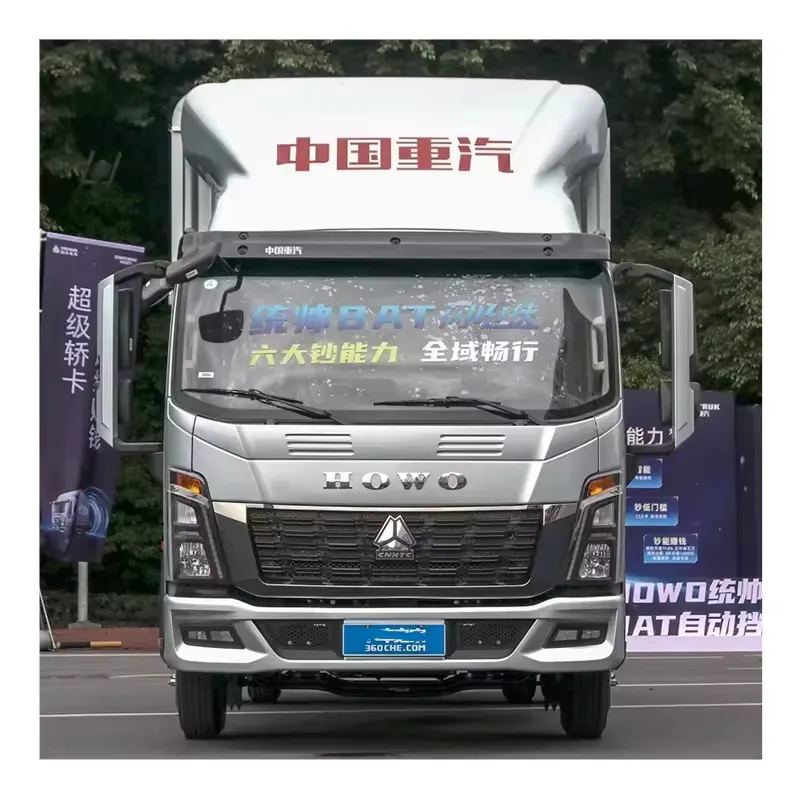24-D10, Aedificium 3, Aosheng Aedificium, Via Shunhua Road, Jinan, Shandong, China +86 13953140536 [email protected]
Successus cuiuslibet operationis logisticae magnopere pendet ex qualitate et idoneitate eius navis aliquet . Quum catenae supply globales videntur esse complexiores, legere iusta vehicula pro tua grege requirit diligentem considerationem plurium factorum. Rationabiliter de camionibus mercimonii decernere potest differre inter excellentiam operativam et onerosas inaniitates quae impingunt in ultimam lineam tuam.
Hodierni logistici administratores incolunt transformantem industriae regionem, ubi efficacia in combustionibus, sustentabilitas et technologiae coniunctio partes principales agunt una cum antiquis considerationibus ut vehendi potestas et durabilitas. Horum elementorum cognitione perfecta, tua in camionibus mercenariis investitura exacte conveniet cum tuis operativis necessitatibus et futurae incrementi rationibus.
Quando camiones mercenarios aestimas, motorum descriptiones primariam attentionem merebuntur. Moderni motorum diesel varia vim producunt, saepe inter 280 et 600 equos fortium, secundum propositum applicationis. Nodus est in medio puncto inter sufficientem vim pro tuis sarcinis habendam et optimalem combustionis efficacitatem servandam reperiendo.
Praeterea in mercatorum vehiculis recentibus technologiae motuum provectae continent emendatas systemates caliditatis curandae, systemates iniectionis subtiliores, atque formas aerodynamicas quae consummationem carburis minuunt. Haec praeterea non solum expensas operativas minuunt, sed etiam adiuvant ad satisfaciendum crescentes rigorosas regulas de ambiente.
Capacitas maxima portandi ponderis mercatorum vehiculorum directe influat in efficaciam et rationabilitatem operativam. Cogita non solum de totius vehiculi pondere permisso (GVWR) sed etiam de capacitate spatii mercimonii. Vehicula mercimonii recentia varia corporis schemata offerunt, a thecis communibus ad speciales unitates ad quasdam mercimonii species destinatas.
Considerationes de dimensionibus includere debent compatibilitatem cum locis onerandis, prohibitiones itinerum, et necessitates mobilitatis. Tendentia ad vehicula mercimonii alti cubi reflectit crescentem petitionem pro maxima spatii efficacia, praesertim in logistica commercii pernét.

Moderni camiones onerarii muniti sunt praeterea his quae tutos sint conductores et onus. Hic numerus comprehendit moderationem stabilitatis electronica, frenationem automaticam in casu periculi, monitores praemonitionis discessus de via, et moderationem velocitatis adaptivam. Haec auxilia non solum tutitatem augent, sed etiam minuere possunt expensas annuas et meliorem numerum retentionis conductorum promovere.
Incorporatio systematum remissionis collisionis in camionibus onerariis effectum mirabilem in minuendo numero casuum habet. Hi systemi technologiam radarum et cammarum adhibent ad circulum visum et conditiones viarum explorandas, praebendo conductoribus auxilium necessarium in situ periculosis.
Hodierni camiones onerarii tamquam centra mobilia informationis fungebantur, notiones utiles per systemata telematica generantes. Hi systemata examinant functionem vehiculi, aedilitatem ergandi, rationem regendi, et necessitates conservationis tempore recto, sententias rationis gestae prospicientes confirmantes.
Capabilities of integration cum software gestionis vehiculorum existentis oportet esse considerationem principalem. Camionibus modernis oportet transmissionem et analysin datorum sine saltu supportare, ita ut optimizari possint viae, schemata mantentionis, et consuetudines consumptionis carburantis.
Consequens pecuniaria camionum longe procedunt ultra primum emptionis pretium. Intervala mantentionis regularia, adstrepitio partium, et texitura servitii rete significantur in expensis operationum. Camiones moderni saepe longitudinem intervalorum servitii et meliorem durabilitatem componentium proferunt, reducendo tempus intermissionis et expensas mantentionis.
Cogita de conditionibus pacti praesidii fabricatoris et de centris servitii autoritatis in locis operationum tuis. Alii fabricatores copias servitii completas offerunt quae in pretium emptionis includi possunt, praebendo meliorem praedictabilitatem pecuniariae.
Valor residuus camionum mercatorum magni momenti est in calculo totius summae expensarum. Factores qui ad valorem venditionis secundae pertinent notorietas marcae, historia conservationis, et postulatus mercati pro configurationibus certis includuntur. Quidam fabricatores altiorem venditionis valorem servant propter probatam fidem et validam mercati praesentiam.
Cicli substitutionis optimi planificare pro camionibus mercatorum conservationis expensas contraponendas habet deprecationis celeritati. Moderatae rationes gestionis agminis saepe praedictivam analysin adhibent ut tempus maxime aequabilem substituendi vehicula determinent.
Cum regulis environmentalibus increscenter strictis, camionibus mercatorum idoneis praesentibus et futuris emissionibus normarum esse idoneos est necesse. Multae regiones praescribunt gradatim strictiores conditiones pro emissionibus vehiculorum mercenariorum, quare considerare camionos qui praesentes normas superent ut agmen tuearis in futuro.
Optiones et hybridationes pro carburibus alternativis in camionibus mercimotoriis abundantius fiant. Haec technologia beneficia environmentalia magnifica praebere potest dum dumtaxat praemiorum gubernamentalium particeps fit aut necessitatum clientium de sustentabilitate satisfacit.
Ultra normas emissionis, camiones mercimotorii hodierni complura addunt quae operationes sustentabiles adiuvant. Hic includuntur emendationes aerodynamicae, rotae minore resistentia volubiles, et systemata auxiliaria efficientia energiae. Haec momenta ad minorem impetum ambientalem conferunt dum saepe minuunt expensas operationum.
Cognosce qua ratione electio tua camionum mercimotoriarum cum metis sustentabilitatis et expectationibus clientium tuis conveniat. Multae iam nunc respublicae factorem praestantiae ambientalis in iudicandis provideribus suis considerant, qua de causa operationes itineris sustentabiles praerogativam competitivam fiunt.
Optimum tempus substitutionis camionum mercium saepe inter 4 ad 7 annos variat, secundum factores ut mille passus annuales, conditiones operativae, expensae conservationis, et valorem residualem. Iterata analysim dati de actu vehiculi et tabularum conservationis adiuvat tempus substitutionis maxime aequabilem pro tua operatione determinare.
Camionae mercium Euro 6 minores emissionis valde praebent quam vehicula Euro 5, praesertim respectu oxydorum nitrogenii (NOx) et materiae particulatae. Saepe systemata magis elaborata contrahendendi emissiones includunt, inter quae reductio catalytica selectiva (SCR) et filtra particulata diesel (DPF), quae ad operationem puriorem ducunt sed fortasse altiores conservationis necessitates.
Alternativis energiis vehicula ferna, inter quae electrica, gasis naturalis, et cellulis hydrogini combustibilibus, praebentur sese magis magisque ut optiones utilis. Haec electio consideranda est ratione necessitatum operationis, aditum ad instrumenta, summae expensae dominii, et finium environmentalium. Multi iam incipiunt parvis programmatibus explorandis ad iudicanda haec instrumenta in certis suis usibus.